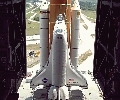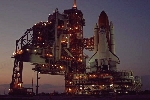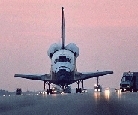- text as of last publication -
![]() Operations
Operations
------------
LAST! The Second Return to Flight Mission Successfully Landed Last Monday, July 17th At the KSC!
The Second Return to Flight Mission successfully landed at the Shuttle Landing Facility of the Kennedy Space Center last Monday, July 17th at 9:15 a.m. EDT. The orbiter had performed its deorbit burn at 8:07 a.m. EDT, over off the coast of Sumatra. The mission lasted 12 days, 18 hours, 37 minutes, 54 seconds. The commander and some crewmembers performed a walk around of the orbiter for a post-flight inspection. Senior NASA officials were at the runway as they themselves made a quick walk around of the shuttle. They greeted the crew as the latter eventually boarder the Astrovan to get back to their quarters
The Second Return to Flight Mission had launched on Tuesday, July 4th, at 2:37:51 p.m. EDT and docked at the ISS on Thursday, July 6th, at 10:52 a.m. EDT, after a 44-hour, 30-minute journey. The Second Return to Flight Mission's mission was to continue to evaluate the Space Shuttle's ability to resume space flights, following the dramatic accident of shuttle Columbia in February 2003. Three spacewalks have been performed, cargo has been transfered from the Shuttle to the ISS and back, as new procedures and repair techniques for the orbiter has been further tested. This mission may be considered like a success as no major hindrance came, related to the recurrent insulating External Tank foam. The thermal protective shield of the orbiter has been found about flawless after the Shuttle's landing last updated: Jul. 17th, 2006
. see more:
. mission timeline
. mission's countdown
. special landing! check below!
. see our mission's gallery below!
------------
The STS-121 mission is the Second Return to Flight Mission. As the first Return to Flight Mission (STS-114) had been marred by the recurrent question of the foam debris falling from the External Tank (ET), leading to an extra spacewalk to fix potentially dangerous damages caused at under the nose of the orbiter, the following missions had been postponed until a definitive question be found to the problem. The 'Flight Readiness Review' held by NASA senior managers and engineers to assess whether the shuttle's complex processes and procedures are ready for flight, decided that shuttle Discovery -mission STS-121, Second Return to Flight Mission- was fit to launch July 1st! The question of the foam debris has been solved in that sense that the foam ice/frost ramp structures covering 34 brackets on the External Tank were estimated not posing sufficient risk to delay the mission. Design improvements however are underway for the next upcoming missions. It has to be noted that some dissent opinions were expressed by NASA's engineers about the reliability of the Space Shuttle in relation to those recurring troubles, making this Second Return to Flight Mission controversial somewhat
![]() PLUS RECENT! La Seconde Mission de Retour au Vol s'est posée avec succès lundi 17 juillet, au Kennedy Space Center!
PLUS RECENT! La Seconde Mission de Retour au Vol s'est posée avec succès lundi 17 juillet, au Kennedy Space Center!
La Seconde Mission de Retour au vol s'est posée avec succès le lundi 17 juillet, sur la piste du Shuttle Landing Facility au Kennedy Space Center à 16h 15 heure française. La navette avait procédé au "deorbit burn", cette mise à feu des moteurs pour ralentir et quitter l'orbite, à 14h 07. La navette était alors au-dessus de l'Océan Indien, au large des côtes de Sumatra. La mission STS-121 a duré 12 jours, 18 heures et 54 secondes. Après l'atterrissage, le commandant et quelques membres d'équipage ont, comme d'habitude, procéder à une inspection post-vol de la navette. Des officiels de haut rang de la NASA étaient sur la piste pour accueillir l'équipage. Ils ont eux-mêmes inspecté rapidement la navette. L'équipage, ensuite, a repris l'"Astrovan", cet autobus qui leur sert de navette, et on rejoint leurs quartiers
Le lancement de la Seconde Mission de Retour au Vol avait eu lieu le mardi 4 juillet à 20h 37 mn 51 s heure française et la navette s'était arrimée à la Station Spatiale le jeudi 5 à 16h 52. La mission STS-121 avait pour but de continuer d'évaluer l'aptitude de la navette spatiale à reprendre ses vols spatiaux suite à la perte de la navette Columbia en février 2003. Trois sorties dans l'espace ont eu lieu, du transfert de chargement entre la navette et la Station et réciproquement, et des tests supplémentaires des nouvelles procédures et des techniques de réparation pertinentes à la navette. La mission semble un succès. Aucun des problèmes liés à la question récurrente des débris de mousse isolante du réservoir extérieur n'est venu, cette fois, intervenir dans la mission. Aucune atteinte notable au bouclier thermique n'a été relevée après l'atterrissage. dernière mise à jour: 17/07/2006
voir ci-dessous (en anglais seulement):
. chronologie de la mission
. le compte à rebours
. lien vers notre page sur comment une navette revient sur Terre
. notre gallerie de la mission
------------
La mission STS-121 est la Seconde Mission de Retour au Vol de la navette spatiale. La Première Mission de Retour au Vol avait été gâchée par la question récurrente des débris de mousse isolante du réservoir extérieur et les astronautes avaient dû accomplir une sortie dans l'espace supplémentaire pour travailler à des atteintes potentiellement dangereuses sous le nez de la navette. Les missions suivantes avaient, de plus, été reportées sine die, jusqu'à ce qu'une solution définitive ait été trouvée à ces questions. Les hauts responsables de la NASA, en accord avec les ingénieurs, ont déterminé que la mission STS-121 de la navette spatiale -navette Discovery- était prête et apte au lancement et ont donc fixé la date du lancement au 1er juillet. La question des débris de mousse, qui tombent de la protection du réservoir extérieur de la navette a été réglée en ce que le phénomène n'a pas été estimé comme posant des risques justifiant de retarder le lancement. Des améliorations, cependant, continueront d'étre étudiées pour les missions suivantes. On doit noter que des opinions divergentes, quant à la question des débris de mousse, ont étée exprimées par des membres de la NASA et des ingénieurs
![]() Operations Gallery
Operations Gallery
(none of these pictures are thumbnails; the gallery is in this format only)
 |  | click to the entire gallery | ||
| Shuttle Discovery rolling out of the VAB, May 18-19. picture NASA/Kim Shiflett | Shuttle Discovery arrived at launch pad 39B, with its rotating structure, May 18-19. picture NASA/Ken Thornsley | |||
![]() Mission's Countdown and Timeline
Mission's Countdown and Timeline
.see the mission's countdown
.see a simplified mission's timeline
![]() Special Landing!
Special Landing!
see our fine page on how a Space Shuttle is coming back from space!
->Deorbit Timeline For the First KSC Landing Opportunity, Monday, July 17th (all times CDT)
3:13am…………..Deorbit Prep begins
4:24am..…….......PLBD Closing
4:36am......………MCC “Go” for Ops 3 Transition
5:40am......………Clothing Configuration
6:04am......………Seat Ingress
6:16am..….……...OMS Gimbal Check
6:30am..…...….…APU Prestart
6:45am.....…..…...MCC “Go-No Go” Decision for the Deorbit Burn
6:52am.....…..……Maneuver to the Deorbit Burn Attitude
7:04am...........…...Deorbit Burn
8:07am.....……….KSC LANDING
text NASA
STS-121, 18th ISS Flight (ULF1.1), Second Test Mission. Multi-Purpose Logistics Module
 |
STS-121, 18th ISS Flight (ULF1.1), Second Test Mission. Multi-Purpose Logistics Module
-> As far as the question of the External Tank (ET) insulating foam is concerned, the solution is now to fly the ET without its protuberance air load ramps, a potential source for debris. The ET is to be checked next week. There won't be any tanking test prior to the mission, on the other hand (the test will be performed during the countdown real tanking)
5:15 a.m. Crew wakes up
10:10 a.m. Breakfast
10:48 a.m. Weather briefing for STS-121 commander and two crew members
11:30 a.m. Astronauts put on flight suits
11:58 a.m. Depart for launch pad
12:28 p.m. Arrive at white room and begin to enter Discovery
1:43 p.m. Close crew hatch
3:49 p.m. Launch
| What's going on after liftoff? Check this sequence of the events! | |
| T-6.5 sec | the 3 main engines ignite |
| T-0 | the two Solid Rocket Boosters (SRBs) ignite; the Shuttle is released |
| Into the flight | the main engines are throttled back to reduce aerodynamics load ("Q") due to the thick lower atmosphere. Engines are throttled up back when the atmosphere becomes thinner |
| T+2:00 mn | SRBs burn out. Throttle back again to ease the SRBs being jettisoned. Small rockets help to disconnect them, and push them away, from the shuttle and the External Tank. The main engines alone continue to push (the acceleration reaches its maximum of 3 G), as the throttle is controlled to reduce stress on the shuttle's structure and passengers |
| T+8:30 | main engines shut down (Main Engine Cutoff, MECO), the External Tank is jettisoned. The shuttle is short of orbital speed. This is done to ensure that the tank doesn't go orbital but falls back instead and burns into the atmosphere |
| MECO+45 | after 45 mn coasting, the shuttle fires two small Orbital Maneuvering System engines, which are giving the final nudge to orbit. The shuttle is now orbiting! |
![]() What in Case of An Aborted Launch?
What in Case of An Aborted Launch?
 |
| the Shuttle landed. picture NASA |
 |
| launch pad 39B, KSC. picture NASA |
->for more, see the official Shuttle page at NASA
Website Manager: G. Guichard, site 'Amateur Astronomy,' http://stars5.6te.net. Page Editor: G. Guichard. last edited: 12/28/2010. contact us at ggwebsites@outlook.com